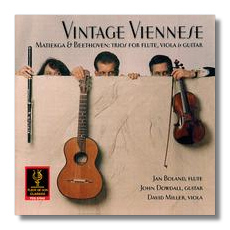
The Internet's Premier Classical Music Source
Related Links
- Latest Reviews
- More Reviews
-
By Composer
-
Collections
DVD & Blu-ray
Books
Concert Reviews
Articles/Interviews
Software
Audio
Search Amazon
Recommended Links
Site News
 CD Review
CD Review
Vintage Viennese

Flute Trios
- Wenceslaus Matiegka: Grand Trio
- Ludwig van Beethoven: Serenade, Op. 8 (arr. Matiegka)
Jan Boland, flute
John Dowdall, guitar
David Miller, viola
Fleur de Son FDS57945 DDD 68:57
The two composers on this CD had a lot in common. They were born in the 1770s, they moved to Vienna when they were young, they remained active there, and they wrote chamber music that was published by the same firm. One composer, however, is very well known; the other is quite obscure. I'll let you guess which one is which.
Wenceslaus Matiegka, born in Bohemia in 1773, wrote solo and ensemble music for the guitar. He must have liked Beethoven's opus 8 Serenade, because not only did he arrange it for violin, viola, and guitar, he wrote a Grand Trio which resembles it in style. The performers on this CD take the arranging one step further by adapting the violin parts of both works for flute. (This isn't made clear until you read the booklet notes almost to their end.) So, what we hear on this CD is an arrangement, once removed, of the Matiegka, and twice-removed of the Beethoven. The combination of flute, guitar, and viola is delightful. Be advised, though, that "substituting the flute for the violin parts necessitated some adjustments," mostly because the flute and the violin have different ranges, and because the flute can't play pizzicato.
The booklet notes also hint that Matiegka's Grand Trio might be better than its model. I'm not sure about that, but I have no doubt that it is music that should not fail to please most listeners with its playfulness. The fourth movement is a "Menuetto à la Polacca" (Minuet in the style of a Polonaise), which sounds self-contradictory, but it hardly matters, given the music's high spirits. The Rondo's chirpy qualities probably are emphasized by the use of the flute. Although there's nothing about the Grand Trio that "pushed the envelope" of music in early 19th-century Vienna (let alone today), it's cheerful and well-crafted, and it rests easily on the ear.
Beethoven's seven-movement Serenade begins and ends with an unpompous march. A long and evening-cool Adagio follows, and then the Menuetto is almost curt in the formality of its gestures. The unusual fourth movement alternates slow and fast sections; even in his twenties, Beethoven was experimenting with form. Next comes an Allegretto à la Polacca that must have made a deep impression on Matiegka, given the similarities between the corresponding movements. Another foretaste of later Beethoven comes in the sixth movement, which is a set of variations on a courtly theme.
Boland, Dowdall, and Miller play instruments from the 19th century. Boland's flute, in particular, has a wistful character. There are some passages that test the players' intonation; one can hear the difficulties, but the difficulties are overcome. The performances are no larger than the music, which is as they should be. I gather that Boland and Dowdall regularly perform together, and that Miller is the "guest violist." (No viola jokes, please.) This disc has gracious engineering courtesy of Peter Nothnagle; the recording was made in the Cedar Rapids Museum of Art in Cedar Rapids, Iowa.
This CD will appeal mostly to listeners who enjoy the flute-guitar combination, or for anyone who enjoys the smaller pleasures afforded by chamber music between Haydn and Beethoven at their respective peaks.
Copyright © 2001, Raymond Tuttle



















